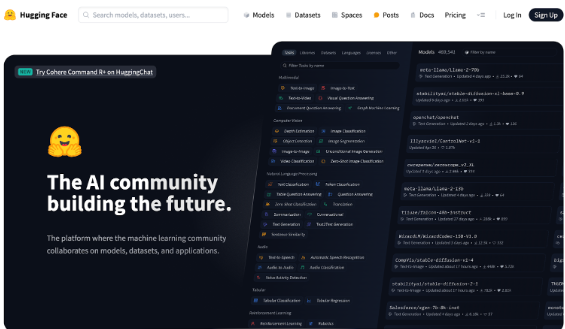What is Hugging Face? Everything we know about the ML platform
As AI models explode in popularity, Hugging Face is a platform to find new ones and experiment

Hugging Face is a leading AI platform known for its open source tools and model repositories.
Originally created as a chatbot company, it pivoted to focus on machine learning, particularly in natural language processing (NLP). The platform provides access to thousands of pre-trained models, making it easier for developers to integrate AI into their applications.
Hugging Face is widely used in research and enterprise AI, supporting everything from text generation to image recognition, with a strong emphasis on collaboration and accessibility.
This article was correct as of February 2025. AI tools are updated regularly and it is possible that some features have changed since this article was written. Some features may also only be available in certain countries.
- Try out Hugging Face on its website
- We've rounded up the best AI tools – ChatGPT, DeepL, Midjourney, and more
What is Hugging Face?
Founded in 2016 by Clément Delangue, Julien Chaumond, and Thomas Wolf, Hugging Face started as a chatbot app but evolved into a major force in AI research.
The company is best known for its Transformers library, which provides implementations of transformer-based models such as BERT, GPT, and T5. These models power applications in text classification, summarisation, translation, and more.
Hugging Face also hosts a Model Hub, an extensive repository where developers can find pre-trained AI models and datasets for various tasks.
Are you a pro? Subscribe to our newsletter
Sign up to the TechRadar Pro newsletter to get all the top news, opinion, features and guidance your business needs to succeed!
The platform supports both PyTorch and TensorFlow, making it highly flexible for AI development, and also offers Spaces, a collaborative environment where users can build and share AI-powered applications.
What can you use Hugging Face for?
Hugging Face is primarily used for natural language processing tasks, such as text generation, sentiment analysis, and chatbot development. Researchers use its Model Hub to access pre-trained AI models, which can be fine-tuned for specific applications without requiring massive computing resources.
Beyond NLP, Hugging Face has expanded into computer vision and speech processing, offering models for image classification, object detection, and text-to-speech synthesis.
Businesses use the platform to integrate AI features into their apps, while educators and students can leverage its tools for learning and experimentation.
Hugging Face is also valuable for AI model benchmarking and evaluation.
What can’t you use Hugging Face for?
Hugging Face is not a full-fledged AI deployment platform for large-scale production environments. While it provides inference endpoints and APIs, heavy-duty AI applications may require custom cloud infrastructure beyond what Hugging Face offers.
The service also lacks built-in tools for real-time AI applications like self-driving cars or industrial automation. Additionally, some proprietary AI models (such as OpenAI’s GPT-4) are unavailable on the platform, limiting access to the most cutting-edge innovations in certain areas.
How much does Hugging Face cost?
Hugging Face follows a freemium model. Public models and datasets are free to use, while the Pro plan costs $9 per month, offering faster API access and premium features.
Businesses can opt for the Enterprise plan, which starts at $20 per user per month, providing additional security, governance, and customer support.
Hugging Face also offers Inference Endpoints, where pricing depends on usage, helping to keep costs down. Some GPU-powered Spaces require additional fees based on hardware resources.
Where can you use Hugging Face?
Hugging Face is accessible via its web-based platform, where users can explore models, datasets, and Spaces. Developers can integrate Hugging Face into their projects using Python libraries and APIs.
It also supports cloud deployment through platforms like AWS. The platform is compatible with Google Colab and other cloud-based notebooks.

Is Hugging Face any good?
Hugging Face is widely regarded as a top-tier AI platform thanks to its open-source philosophy and ease of use. Many developers appreciate its vast Model Hub and Transformers library, which simplify the complex process of AI model training and deployment.
However, some users find that large-scale AI applications require additional infrastructure, as Hugging Face’s hosted services can be expensive for production use.
Despite this, its active community, frequent updates, and broad AI model support make it one of the most valuable resources for AI developers.
Use Hugging Face if
- You need pre-trained AI models for NLP, computer vision, or speech recognition.
- Hugging Face is ideal if you want to fine-tune AI models without building them from scratch. Researchers, businesses, and developers looking for open source AI tools and cloud-based model hosting will benefit from the platform.
- It’s also great for educators and students who want to experiment with cutting-edge AI without needing expensive hardware, either for fun or for work.
Don’t use Hugging Face if
- You need a fully managed AI production platform. While Hugging Face provides APIs, complex deployments often require custom infrastructure. If your project demands proprietary AI models (like OpenAI’s GPT-4), you won’t find them here.
- Additionally, if you require real-time AI applications for autonomous vehicles or robotics, Hugging Face may not be the best fit. Businesses handling highly sensitive data might also need stronger security and compliance controls than what Hugging Face’s public model hub offers.
Also consider
If you’re looking for alternatives to Hugging Face, consider OpenAI’s API, which provides access to powerful AI models like GPT-4 for text generation and DALL·E for image creation.
Google Vertex AI is another option, offering enterprise-grade AI tools with strong integration into Google Cloud.
Amazon SageMaker is ideal for businesses needing a fully managed platform to train, deploy, and scale AI models with built-in security and compliance features.
Want to read more about Hugging Face?
Max Slater-Robins has been writing about technology for nearly a decade at various outlets, covering the rise of the technology giants, trends in enterprise and SaaS companies, and much more besides. Originally from Suffolk, he currently lives in London and likes a good night out and walks in the countryside.
You must confirm your public display name before commenting
Please logout and then login again, you will then be prompted to enter your display name.